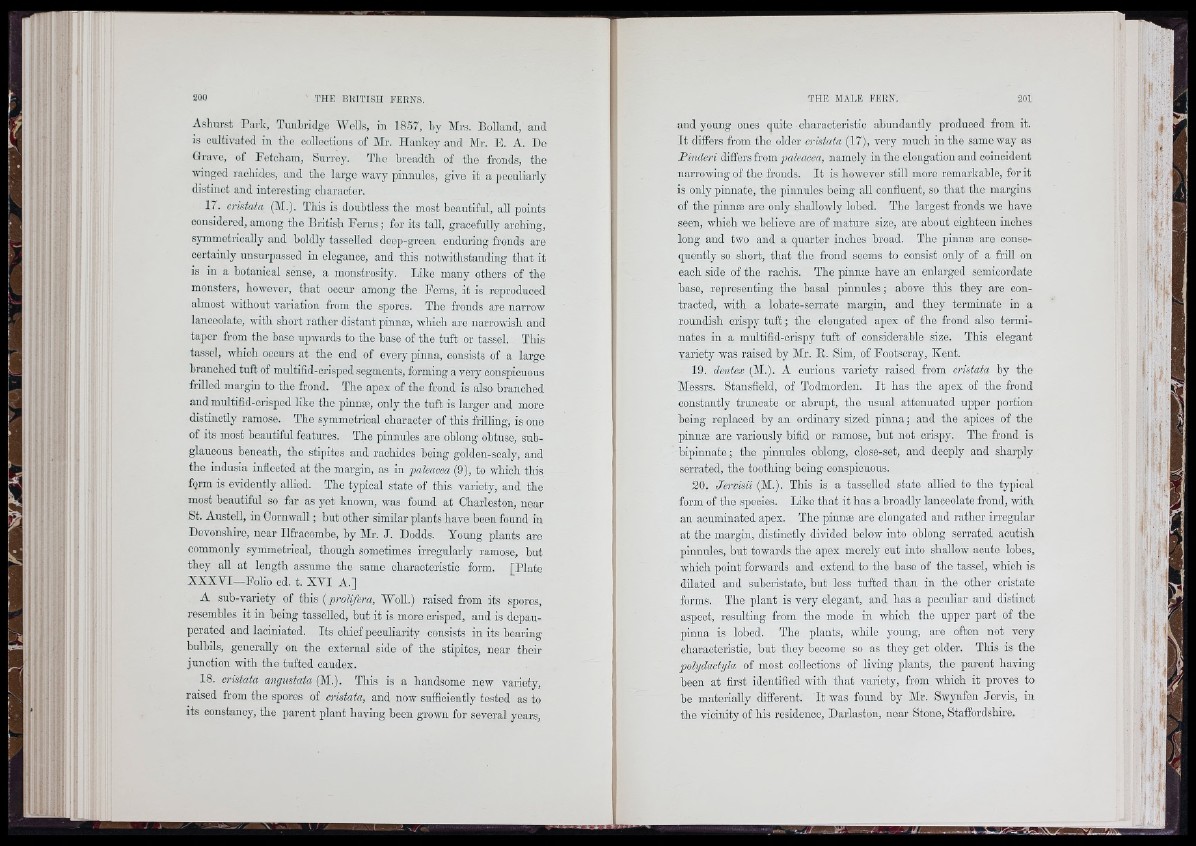
Asliurst Tark, Tunbriilgo Wells, iu 1857, Ly Mrs. Eolland, and
is cultivated iu the collections of Mr. Kankoy and Mr. L. A. ])c
Grave, of Fetcliam, Surrey. Tbo breadth of tho fronds, tho
wdngcd rachidos, and tho largo wavy pinnules, give it a peculiarly
distinct and interesting character.
l i . cristata (M.). This is doubtless the most beautiful, all points
considered, among tho British Ferns ; for its tall, gracefully arching,
symmetrically and boldly tasselled doop-grcen enduring fronds are
certainly unsurpassed in cloganee, and this notwithstanding that it
is in a botanical sense, a monstrosity. Like many others of the
monsters, however, that occur among the Ferns, it is reproduced
almost without variation from the spores. Tho fronds arc narrow
lanceolate, with short rather distant pinnæ, which arc narrowish and
taper from tho base upwards to tho base of the tuft or tassel. This
tassel, which ooours at tho end of every pinna, consists of a largo
hranohod tuft of multifid-crispod segments, forming a veiy conspicuous
frilled margin to the frond. Tho apex of tho frond is also branched
and multifid-crispod like the piunæ, only the tuft is larger and more
distinctly ramose. The symmetrical oharaoter of this frilling, is one
of its most beautiful features. The pinnules aro oblong obtuse, sub-
glaucous henoath, the stipites and raohides boing golden-scaly, and
the indusia inflected at the margin, as in paleacea (9), to which this
form is evidently allied. Tho typical state of this variety, and the
most beautiful so far as yet known, was found at Charleston, near
St. Austell, in Cornwall ; but other similar plants have been found in
Devonshire, near Ilfraoomhe, by Mr. J. Dodds. Young plants are
commonly symmotrioal, though sometimes irregularly ramose, but
they all at length assume the same characteristic form. [Plate
XXXVI—Folio cd. t. XVI A.]
A sub-variety of this {proliféra, Woll.) raised from its spores,
resembles it in being tasselled, but it is more crisped, and is depauperated
and laciniated. Its chief peculiarity consists in its hearing
bulbils, generally on the external side of the stipites, near their
junction with the tufted caudex.
18. cristata angustata (M.). This is a handsome new variety,
raised from the spores of cristata, and now sufficiently tested as to
its constancy, the parent plant having been grown for several years.
and young ones quite oharaoteristio abundantly produced from it.
It differs from the older cristata (17), very much in tho samo way as
Pinderi differs from paleacea, namely in tho elongation and coincident
narrowing of tlio fronds. I t is howovor still more remarkable, for it
is only pimiate, the pinnules being all confluent, so tbat the margins
of the pinnæ aro only shallowly lohed. The largest fronds we have
seen, which we heliovo are of mature size, aro about eighteen inches
long and two and a quarter inches broad. Tho pinnæ aro consequently
so short, that the frond soems to consist only of a frill on
each side of the rachis. The pinnæ have an enlarged scmioordato
base, representing tho basal pinnules ; above this they are contracted,
witb a lobate-serrate margin, and they terminate in a
roundish crispy tuft ; tho elongated apex of the frond also terminates
in a multifid-orispy tuft of considerable size. This elegant
variety was raised by Mr. R. Sim, of Footsoray, Kent.
19. dentex (,M.). A curious variety raised from cristata by the
Messrs. Stansfiold, of Todmorden. I t has the apox of tho frond
constantly truncate or abrupt, the usual attenuated upper portion
being replaced by an ordinary sized pinna ; and the apioos of the
pinnæ are variously bifid or ramose, hut not crispy. The frond is
hipinnate ; tho pinnules oblong, oloso-set, and deeply and sharply
serrated, the toothing being conspicuous.
20. Jervisii (M.). This is a tasselled state allied to tho typical
form of the species. Like that it has a broadly lanooolato frond, with
an aouminatod apex. The pinnæ are elongated and rather irregular
at the margin, distinctly divided below into oblong serrated aoutish
pinnules, hut towards the apex merely out into shallow acute lobes,
which point forwards and extend to tho base of tho tassel, which is
dilated and subcristate, but less tufted than in the other cristate
forms. The plant is very elegant, and has a peculiar and distmct
aspect, resulting from tho mode in which the upper part of tho
pinna is lobod. The plants, while young, are often not very
characteristic, hut they become so as they got older. This is the
polydactyla of most collections of living plants, tho parent having
been at first identified with that variety, from which it proves to
be materially different. I t was found by Mr. Swynfon Jorvis, in
the vicinity of his residence, Darlaston, noar Stone, Staffordshire. i ! li
I I-'